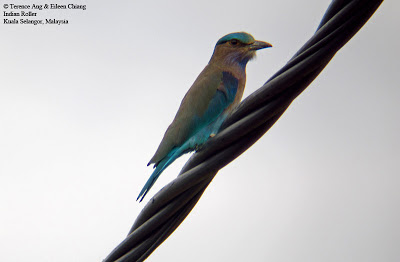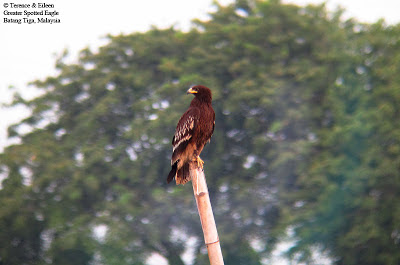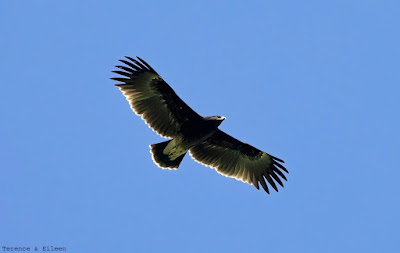Lesser Fish-Eagle Ichthyophaga humilis (Muller and Schlegel) 1841
Lesser Fish-Eagle Ichthyophaga
humilis (Muller and Schlegel) 1841
Other Name: Lesser Fishing Eagle, Himalayan Grey Headed
Fishing Eagle
Resident (NT)
Status and distribution
Common resident (up to 300m) throughout Peninsula
south to Johore. Species occur in inland lake system, river and also forest
waterway. This species can occur in higher number in certain location where
good habitat is available as recorded in Temmenggor Lake
Description
Greyish head and necked. Upperpart brown to dark brown with
blackish or dark brown flight feather. Underpart brown lower breast to mid of
body before cut off by white on thigh, vent and belly. Tail brown. In flight,
blackish brown flight feather with brown underwing covert. Eye yellow, leg and
feet pale yellow. Bill dark with gape and cere blusih.
Juvenile:Pale
brown above. Throat and breast pale brown with breast indistinctly streaked
sometimes unmarked. Thigh, vent and belly pale brown. In flight, form white on
inner wed with narrow dark band across secondaries to primaries.
Confusion Species
Very easily confuse to Grey-Headed Fish Eagle. At rest wing
of the Lesser Fish Eagle both adult and juvenile reaching the tail tip while
the Grey-Headed Fish Eagle are short of tail tip. Distinctively barred dark
terminal band with white subterminal band are good characteristic especially in
flight. Juvenile of the Grey Headed Fish Eagle are more heavily marked and
streak. Check habitat.
Geographical
Variation
I.h.humilis only
known subspecies (Wells 1990 & Fuguson-Lee 2001)
Behaviour
Tend to observed to hunt singly even though nesting. In
large lake it was observed to practice soaring hunting method. In river area
and location where perch are available, the Lesser Fish Eagle was observed to
detect its prey from the perch itself. In many observation bird are observed
hunting between 930am-1045am. The species are known for perching hunter. There
have no documentation for soaring hunting documented as of date. Observation in
Taman Negara remain bird hunting from still perch. It is documented the species
hunt in pair in water body area (lake) however this is not observed in large
river area. Observation for example in Kinabatangan and Taman Negara show
hunting were singly.
Diet were strictly fish (Naroaji 2006), however there is one
record showing pierce on due to snake bite may have suggest that this species
also hunt for swimming fish (Well 1990)
Habitat
Lake, forested river, large river system and also in smaller
stream. None observed in coastal. Riparian area adjacent to river may have been
a good habitat and worth conserving as species are related to river.
Breeding
Raptor nest was observed between 20-30m above ground. Tree
have never been observed to be emerging and nest always situated below canopy. Nest
always situated near water body. Breeding record began in Feb-June (Naroaji
2006) which is rather similar to P.Malaysia. Other document for this species in
breeding are poorly documented.
Photo
https://naturecore.blogspot.com/2013/08/ncrru-lesser-fish-eagle-nikon-p90-eye.html
Reference
Ben
F.King & Edwards C.Dickson, 1989, A Field Guide To The Birds of
South-East Asia, Collins, Grafton Street, London
Betram
E.Smythies 2001, The Birds of Burma, Natural History Publication, Kota
Kinabalu (ISBN 983-812-049-9)
Craig
Robson, 2017, A Field Guide To The Birds of South-East Asia,
Bloomsburry, London
Del
Hoyo, J., Elliott, A & Sargatal,J eds, 1997, Handbook to Birds of
The World Vol 1, Lynx Edicions, Bercolona, Collins, Grafton Street, London
Susan
Myers, 2009, A Field Guide To The Birds of Borneo, Talisman,
Singapore
Boonsong
Lekagul & Philip D.Round, 1991, A guide to the Birds of Thailand, Saha
Karn Bhaet Co., Ltd Bangkok
David
R Wells, 1999, Birds of The Thai Malay Peninsula Vol 1, Academic
Press, London UK
James Fergusan Lee and David A
Christie 2001, Raptors of The World, Christopher Helm, Great Britian
(ISBN 0-618-12762-3)
Rishad Naoroji 2007, Birds of
Prey of the Indian Subcontinent, OM Book International, New Delhi (ISBN 8187107699)








Comments
Post a Comment